VERY RARE! WWII Lt. Gen. George Patton’s Third Army "RESTRICTED" Siegfried Line (FORBACH) Germany Combat Assault Map*
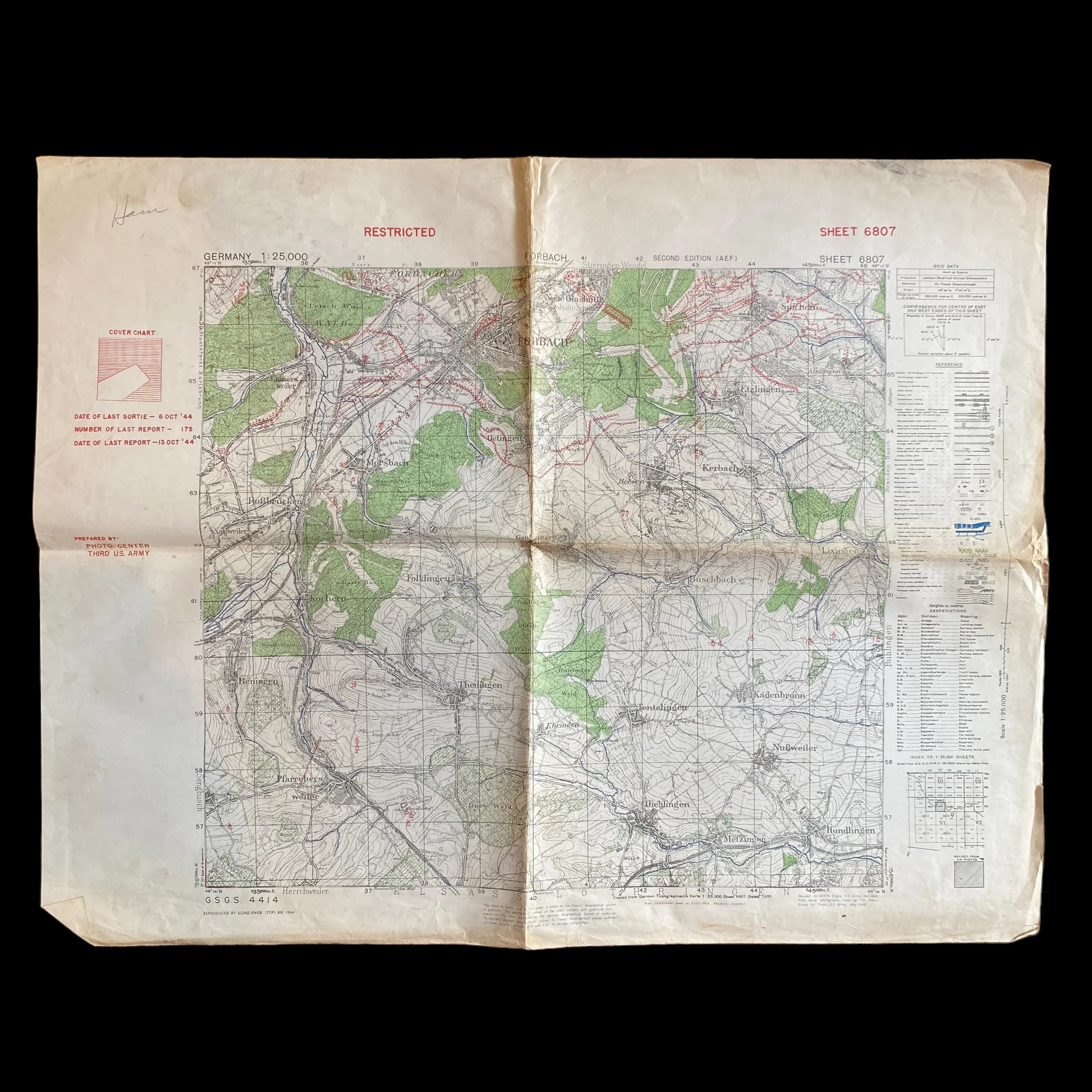
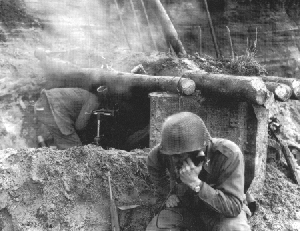





























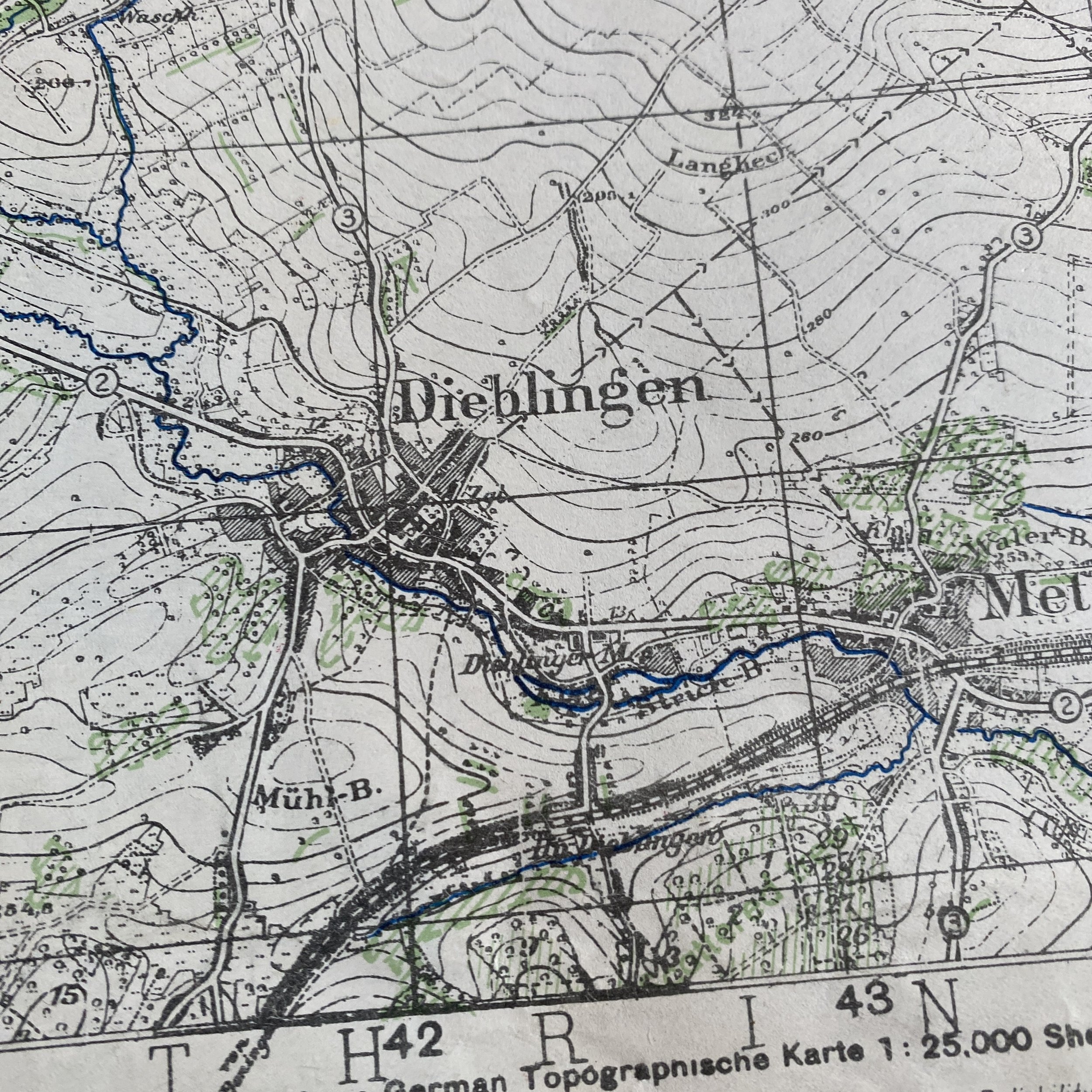


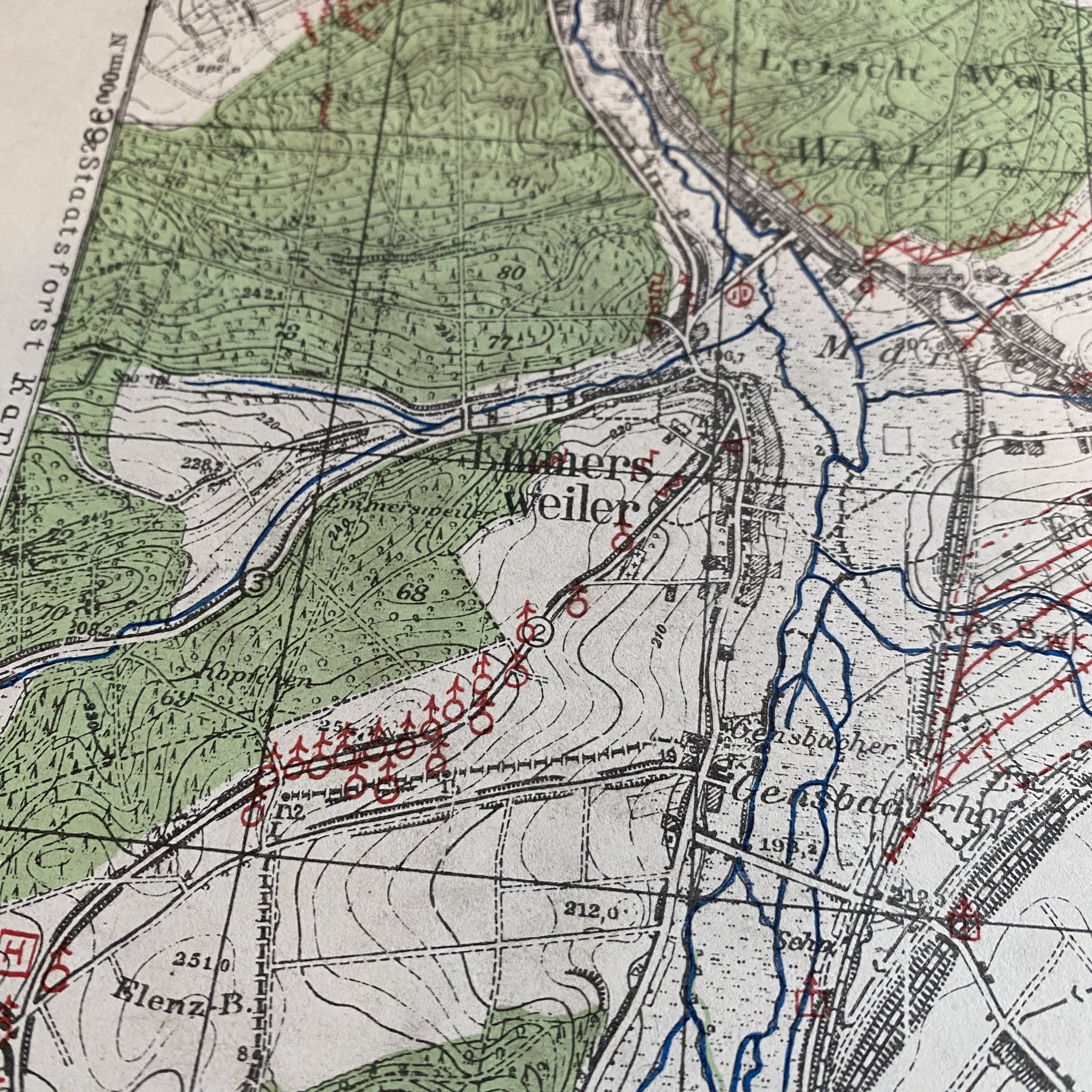







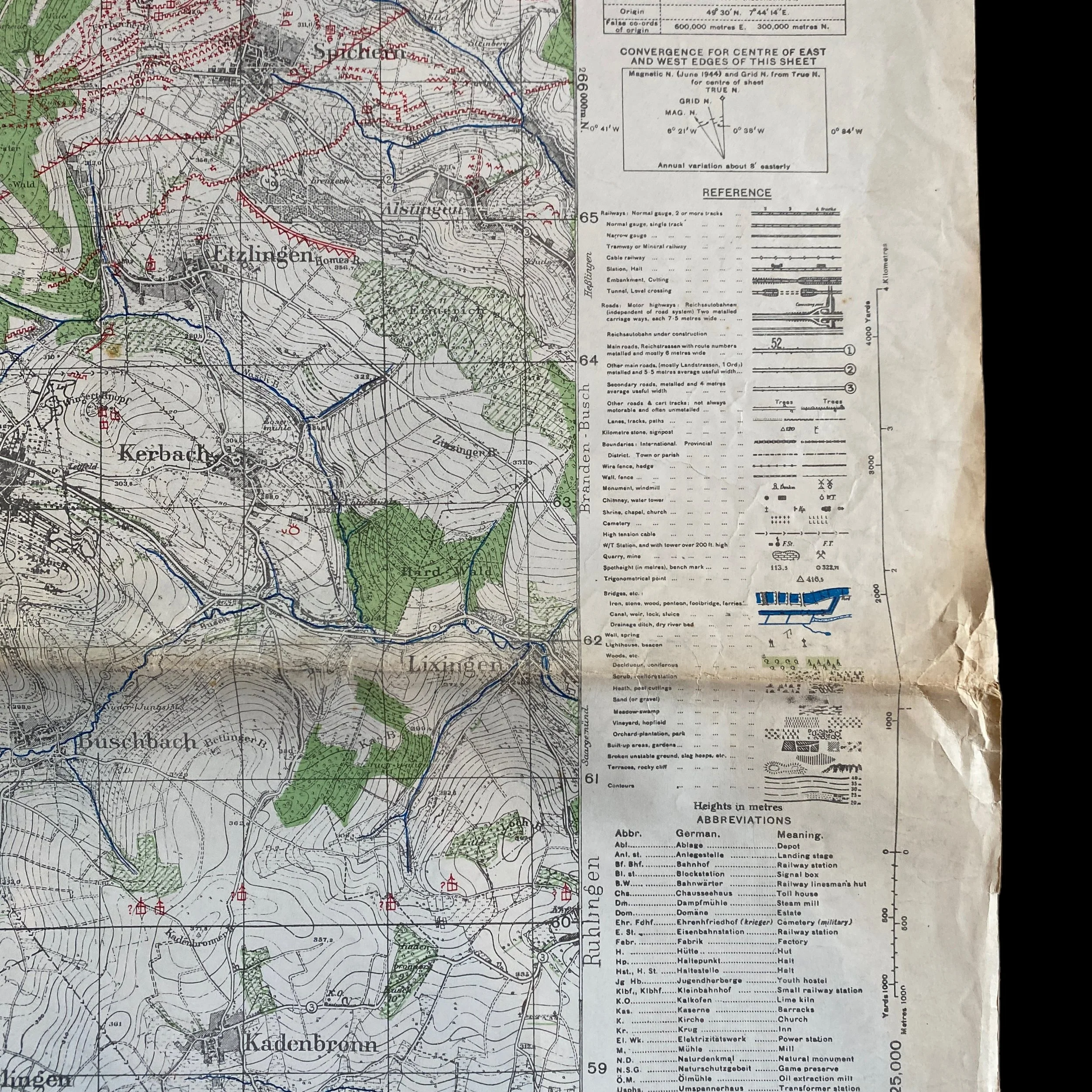





VERY RARE! WWII Lt. Gen. George Patton’s Third Army "RESTRICTED" Siegfried Line (FORBACH) Germany Combat Assault Map*
Comes with C.O.A.
This incredibly rare and museum-grade Lorraine Campaign WWII 1944 Siegfried Line combat assault map was used by Lt. Gen. George Patton’s Third Army in 1944 as U.S. Infantry and Armored Divisions advanced from France into Germany. Also known as The Siegfried Line campaign was a phase in the Western European campaign of World War II which involved actions near the German defensive Siegfried Line. Titled “FORBACH” this combat assault is a very rare edition showing German bunkers, fortifications, machine guns emplacements, mortar positions, artillery, and for the first time the famous Siegfried Line antitank ditches known as the “dragon teeth”.
This phase spans from the end of the Battle of Normandy, or Operation Overlord, (25 August 1944) incorporating the German winter counter-offensive through the Ardennes (commonly known as the Battle of the Bulge) and Operation Nordwind (in Alsace and Lorraine) up to the Allies preparing to cross the Rhine in the early months of 1945. This roughly corresponds with the official United States military European Theater of Operations Rhineland and Ardennes-Alsace campaigns.
This map shows the combat area right next to the town of SAARBRUCKEN where the Germans made massive counterattacks on the American lines.
Battle of Forbach:
After the liberation of Oeting, the immediate objective of the 276th Infantry was Forbach, a well defended French mining center near Saarbrucken, Germany. To reach Forbach, the Trailblazers had to overcome three imposing terrain barriers; the high ground of the Kleinwald covered by thick woods, the ancient Schlossberg Castle towering above a steep hill overlooking Forbach, and to the left of the high ground a well protected narrow valley which the GIs had to traverse. The four-hundred year old tower of Schlossberg served the enemy as an observation post from which their observers directed artillery and mortar fire against the advancing Trailblazers. Automatic weapons covered the valley nearly the entire distance between Oeting and Forbach.On 18 February, under 88 mm artillery fire, intense machine gun fire and terrible cold rain, Companies A and C captured two hills of the Kleinwald and Companies I and L fought to positions where they would attack the castle and nearby barracks the next morning. In the late afternoon of 19 February, [see S-3 Report, 276th] after suffering many casualties, Company I had surrounded the castle, Company L had cleared the barracks and Company A gained a foothold in Forbach by capturing the Marie Madelaine Hospital. The regiment then moved into position to enter Forbach. The 1st Battalion rifle companies plus Company F were on the right, and the 3rd Battalion rifle companies plus Company E were on the left. Heavy weapons companies were in support. That night the Germans intensified their efforts to defend the city by continuous mortar and artillery bombardment of all 276th Infantry positions, including Schlossberg Castle. Small arms, mortars, potato masher grenades and panzerfausts were used against the GIs in the hospital without letup. That determined resistance, which continued all day of 20 February and into the night, held Company A at the hospital and was the Germans' last desperate attempt to drive the Trailblazers back from Forbach. Each attempt to penetrate the German defenses resulted in more wounded and dead GIs but that afternoon General Barnett ordered the Bloody Axe Regiment to attack at once and capture Forbach. "Cut, Slash and Drive!"
At 0800, 21 February, in face of intense machine gun and mortar fire, the GIs attacked, pierced the enemy defenses and broke out into the city. Slowly and methodically, they took house after house in the southeast section of town. It was a costly, bloody ordeal and the number of casualties was astounding. City fighting was a novel experience for the Trailblazers. Heretofore, their combat was in small villages, forests, and mountains. The multi-storied buildings presented much different obstacles to overcome than did the small houses such as in Wingen and Oeting. Each building was in effect a huge bunker, with small basement windows that opened at street level like pillbox embrasures. The solid stone walls varied from several inches to more than three feet thick and many could withstand the impact of 105mm artillery. The Germans knew every building, street, alley, and neighborhood square. They positioned themselves at strategic locations throughout the city where they established strong points; and with minimum manpower, they skillfully defended their lines with rifles, light mortars, burp guns and other automatic weapons. Their forward observers directed mortar and artillery fire on the advancing GIs with unbelievable accuracy.When the men could no longer see what they were attacking, the companies made preparations to hold up for the night and defend the real estate for which they paid so dearly. The men were physically exhausted from the grueling day of storming buildings, running through and climbing over rubble, and from being on the attack for more than a week without letup. Their meager meals were K and C rations often eaten on the run. Nightfall did not present an opportunity to rest. They cleaned their weapons, changed their socks, posted sentries, and some went on patrols to locate enemy positions. The walking wounded made their way back to aid stations and the more seriously wounded were assisted by their buddies. The attack resumed at dawn 22 February when the enemy resistance increased substantially as a result of their bringing up several hundred reinforcements during the night. The line companies continued their painful building-to-building advance to the downtown area. Casualties remained high and speedy evacuation of the wounded became more difficult. In the early afternoon Company A reached the center town square where several streets, including the highway to Oeting, converged on Rue Nationale, the main east-west artery. There the enemy was well established in cellars commanding clear fields of fire down all the intersecting streets. As the GIs approached the square, they were met with a rain of machine gun bullets, sniper fire and mortar shells. The closer they got to Rue Nationale, the more intense and fierce the fighting became. The CO called for artillery and a few minutes later, 105mm shells screeched over the mens' heads and crashed into the enemy occupied buildings across the square. The shells exploded so close to the GIs that they hardly heard them going over, but they felt the concussion and the pressure on their ears. When the shelling ceased, the GIs dashed across the square, threw grenades into the buildings, and burst in with rifles blazing. After crossing Rue Nationale both battalions continued north for a few blocks to the railroad which, with its adjacent yards, appeared to be an impassible barrier. The railroad station on the south side of the main line was deserted and except for a few disabled freight cars, the yards were void of activity, but whenever anyone attempted to get near the tracks all hell broke loose. They were there waiting in strength.
Meanwhile, the 274th Infantry's advance through the forests and mountain ridges east of Forbach met vicious enemy opposition and counterattacks, consequently orders were to hold at the railroad and establish a line of defense until both regiments were on line. For the next few days the men consolidated their positions and mopped-up the last pockets of resistance south of the railroad. The fighting evolved mainly in an exchange of rifle, machine gun and mortar fire. To keep abreast of enemy activities and troop movements, reconnaissance patrols were sent out every night. Likewise German patrolling was active. Heavy artillery shells and nebelwerfers (screaming-meemies), whose blasts were horrendous, hit Forbach day and night. By 2 March the 274th Infantry had captured the mountain ridges east of Forbach, and the right flank of the 276th Infantry was no longer exposed. 3 March at 0800, in a cold rain, the Regiment attacked across the railroad with the 1st Battalion on the right and the 3rd Battalion on the left. Riflemen of the assault companies entered and captured houses in their respective sectors less than ten minutes after crossing the line of departure. In an attempt to get through an underpass, Companies K and A met small arms and automatic weapons fire from straight up the road and land mines prevented the attached tank platoon from passing through the underpass. An engineer mine platoon was summoned to clear the way for the tanks and a concentration of 240mm artillery blasted the hell out of enemy fortified positions. The heavy artillery barrage enabled the GI's to continue the perilous business of running from street to gutter to doorway, throwing hand grenades in windows and cellar embrasures, climbing and stumbling over rubble, and bursting into buildings. They attacked from door to door, building to building, and block to block to the northern edge of Forbach and on into the Forbach Forest. By that time the combat infantrymen were totally exhausted, hungry and wet from many days of close combat in the miserable cold rain. They were bruised and cut from falling in rubble and broken glass that littered the pot-holed cobblestone streets, but they pushed on toward Germany.
At this point, the German engineers had improved the Siegfried Line references to the point that it was the strongest section of the entire 390-mile fortified zone. Marked “RESTRICTED” this U.S. combat assault map was specially made to aid U.S. Infantry and Armored Divisions in assaulting the Siegfried Line. On the map, you can see clearly the line of German antitank barriers and reinforced concrete pillboxes and bunkers.
The Siegfried Line combat assault by Lt. Gen. George Patton’s Third Army in late 1944 on the Saar River and Merzig was a critical battle in the closing stages of World War II. The battle marked a significant turning point in the war, as it represented the first successful breach of the heavily fortified Siegfried Line, which had long served as Germany’s primary line of defence against an Allied invasion.
The Siegfried Line was a massive system of fortifications that stretched for hundreds of miles along the western border of Germany. The line consisted of concrete bunkers, anti-tank obstacles, and barbed wire entanglements, and was designed to slow down an invading army and provide time for the German army to mobilize and respond to an attack.
In late 1944, as the Allies continued their advance into Germany, Patton’s Third Army was tasked with breaching the Siegfried Line and pushing the German army back across the Saar River. The assault was a formidable challenge, as the Third Army was faced with a well-entrenched and determined enemy, as well as difficult terrain and harsh weather conditions.
Despite these challenges, Patton’s Third Army was able to achieve a decisive victory over the German forces in the Saar River and Merzig areas. The battle was fought with incredible ferocity and determination, with both sides showing remarkable bravery and resilience in the face of heavy casualties.
One of the key factors in the Third Army’s success was Patton’s aggressive and unorthodox tactics. Unlike many other military leaders of the time, Patton was known for his willingness to take risks and to think outside the box. He believed in the importance of speed and surprise, and he put these principles into action in the Siegfried Line assault.
One of the most notable examples of Patton’s unconventional tactics was his use of armored vehicles in the assault. He realized that the heavily fortified bunkers of the Siegfried Line would be nearly impervious to direct attacks by infantry, and he therefore ordered his tanks and armored vehicles to take the lead in the assault. This strategy allowed the Third Army to quickly break through the enemy’s defenses and establish a foothold on the other side of the Saar River.
Another critical factor in the Third Army’s success was the relentless determination of its soldiers. Despite the difficult conditions and heavy casualties, the soldiers of the Third Army fought on with incredible bravery and determination. They were motivated by a deep sense of duty and a desire to bring an end to the war and restore peace to Europe.
In the end, the Siegfried Line combat assault was a decisive victory for the Allies, and it marked a critical turning point in the war. The success of the Third Army in breaching the heavily fortified Siegfried Line paved the way for the final push into Germany and the eventual defeat of the Nazi regime.
The Siegfried Line combat assault was a testament to the bravery and determination of the soldiers who fought in the battle, as well as the strategic brilliance of their leader, General George Patton. It remains an important event in the history of World War II, and it serves as a reminder of the sacrifices made by those who fought and died to secure freedom and peace for future generations.